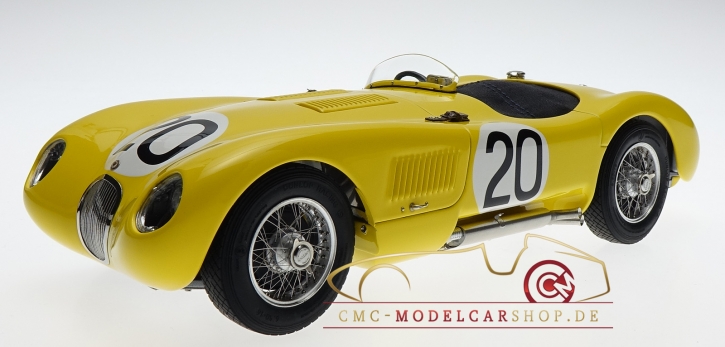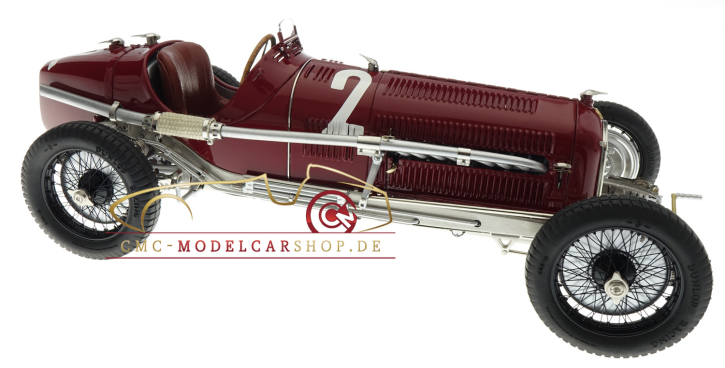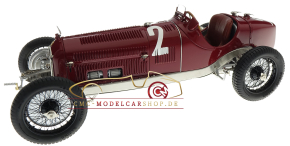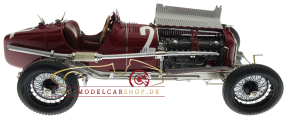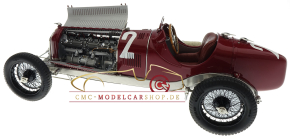547,00 EUR 620,00 EUR you save 11.8% (73,00 EUR)
incl. 19 % VAT excl. shipping costs
delivery time: 3-7 Werktage innerhalb Deutschland
Product.Nr.: CMC M-220
product description
A masterpiece of architecture model:
M-220 CMC Alfa Romeo P3 Caracciola, WINNER GP Germany 1932, #2
The Alfa Romeo Tipo B was the most successful single-seater Grand Prix racing car of its time. Alfa Romeo built and raced it between 1932 and 1936. Initially as a factory race car for Alfa Corse, then later under the Scuderia Ferrari label after having taken over Alfa Romeos racing activities. The car, designed by the legendary engineer Vittorio Jano, was based on the equally legendary Alfa Romeo 8C models. The P3 was Alfa Romeos second single-seater after the Tipo-A monoposto of 1931.
The Alfa Romeo Tipo B was the most successful single-seater Grand Prix racing car of its time. Alfa Romeo built and raced it between 1932 and 1936. Initially as a factory race car for Alfa Corse, then later under the Scuderia Ferrari label after having taken over Alfa Romeos racing activities. The car, designed by the legendary engineer Vittorio Jano, was based on the equally legendary Alfa Romeo 8C models. The P3 was Alfa Romeos second single-seater after the Tipo-A monoposto of 1931.
Technical data of the CMC-model:
- Model: Diecast, assembled, handmade precision metal model
- Manufacturer: CMC GmbH, Classic Model Cars, Germany
- Scale: 1:18
- Art.-No.: M-220
- Color: Red
- Parts: 1,805
- Limited Edition: 1,000
Model car details:
- Hand-assembled precision model from 1,805 parts, including over 85% metal
- Authentic and true-to-scale monoposto body
- Precise stainless steel ladder frame
- Bonnet can be opened on both sides with spring fasteners
- Highly detailed eight-cylinder in-line engine with two Roots superchargers complete with ancillary units, routing, and wiring
- Hand-assembled wheels with aluminum rims and stainless-steel spokes mounted on base nipples
- Detachable wheels fastened by central locking nuts that feature side-dependent threads
- Detailed steering and brake linkage
- Functional petrol, water and oil filler caps
- Authentic cockpit with leather seat
- Originally designed dashboard with all gauges and controls
- Front and rear suspension faithfully reproduced with leaf springs and friction shock absorbers
- Removable floor pan after loosening the screws
Description of the original vehicle:
The Automobilclub von Deutschland hosted the 1932 Grand Prix Germany on the 22.81 km-long North Loop of the Nürburgring; which was considered the most difficult race circuit after the Targa Florio. Racecars were divided into three groups. Group I consisted of the cars that were contesting the European Championship without limitation of engine displacement (unlimited class). They had to drive 25 laps for a total distance of 570.25 km. Cars that did not have to drive 25 laps, did not qualify for overall victory or the European Championship. Equipped with engines ranging from 800 cc up to 1500 cc, Group II cars had to drive 23 laps. The smaller cars of Group III with engines ranging from 350 cc up to 800 cc had to drive 19 laps. There were no limitations in terms of engine design, car weight, or fuel type.
Contestants came from Austria, Belgium, Britain, Czechoslovakia, France, Germany, Hungary, Italy, Luxembourg and Switzerland. The first entry of Group I was placed by Rudolf Caracciola, 1931 winner with Mercedes, who would start this year with Alfa Romeo. Due to the economic recession, Daimler-Benz had withdrawn from racing. Among the prominent teams that joined Group 1 was the Alfa Romeo works with a fearsome line-up of Nuvolari, Caracciola, Borzacchini and Campari. Bugatti entered Chiron, Varzi and Divo with Bouriat as reserve. The third works team was Maserati in Bologna, which came with only one 3.0-liter car for Ruggeri.
Another Maserati entry was Count di Cerami’s entirely new 1.1-liter 4-cylinder monoposto with Ernesto Maserati as its driver. There were quite a few independent entries, including Bugatti drivers, such as Dreyfus and Lehoux from France, Longueville from Belgium, Hartmann from Hungary and so on.
During practice prior to the race, most drivers observed that tires would last about seven to nine laps in the hot weather of the Nürburgring. This would become a big problem unless the weather cooled down for the race day. People like Ettore Bugatti, however, had a different concern. Aware that the P3 monoposti were the quickest in practice and that Alfa Romeo had been victorious in nearly all major events that year, they could not but wonder which of the three Alfa drivers had the best chance of being the victor this time. A native of Germany and a triple winner with Mercedes-Benz, Caracciola was at home with the Nürburgring circuit and appeared to have the best odds to be a favored hero except that the daredevil Nuvolari could ignore team orders and pose a threat to him.
July 17 was a Sunday that broke with a foggy, cold, and windy morning, but it did not rain. A total of 31 cars assembled on the starting grid in numerical order. Nine of the sixteen Group 1 entries showed up and lined up in the front, because they were both more important and presumably faster.
Upon the start-off, Caracciola’s (#2) immediately went into the lead, followed by Nuvolari (#10), Borzacchini (#12), and Chiron, Dreyfus, and Lehoux – a gathering of three Alfa monoposti and three Bugattis at the very front. Caracciola finished the first lap seven seconds ahead of Nuvolari and continued to maintain an early advantage ahead of his teammates. On lap four Caracciola was drawing further away from Nuvolari, and the gap widened to 54 seconds after five laps.
Caracciola had been in the lead since the beginning, and on lap seven, he started to ease up a little, probably by 20 seconds. This was enough for Nuvolari to catch up. He was faster than the German on lap eight with a time of 11m10s, gaining on Caracciola visibly on lap nine, and drove his fastest lap on lap ten in 10m49.8s. Caracciola was quite surprised to be overtaken by Nuvolari, who arrived at the grandstand ahead of him and, then, made a pit stop for fuel, oil, water, and tires. The stop cost him 2m40s, and Count Lurani described it as a deliberate delay, “… the directors of Alfa who wanted to avoid internal strife likely to prejudice the final results of the race, arranged matters to delay the little man unduly.”
Nuvolari was briefly in first place after ten laps. Caracciola, however, managed to regain the lead after having talked with Giovannini, the team manager during his pit stop, which took 1m35s. W.F. Bradley reported in The Autocar: “From this time on there was no more competition, and with the exception of a stop of 20 seconds on the part of Nuvolari to verify his oil level, the three Alfa Romeos went through without interruption and without at any time being seriously threatened by their rivals.
The final result after 25 laps put Alfa Romeo in the first three places, with Caracciola as popular and deserving victor, followed by Nuvolari and then Borzacchini. They all finished the race under five hours despite the international five-hour rule. Caracciola had won the 1931 German Grand Prix with an average speed of 67.3 mph on the Nordschleife. This time, in the face of Nuvolari’s challenge, Caracciola had to drive faster than was necessary to win the victory, so his resultant average was a new record of 74.2 mph, which enabled him to cross the finish line in 4h 47m 22.8s.
With this triple win, Alfa Romeo was victorious in the European Championship of Makes while Nuvolari became European Champion of Drivers.
Contestants came from Austria, Belgium, Britain, Czechoslovakia, France, Germany, Hungary, Italy, Luxembourg and Switzerland. The first entry of Group I was placed by Rudolf Caracciola, 1931 winner with Mercedes, who would start this year with Alfa Romeo. Due to the economic recession, Daimler-Benz had withdrawn from racing. Among the prominent teams that joined Group 1 was the Alfa Romeo works with a fearsome line-up of Nuvolari, Caracciola, Borzacchini and Campari. Bugatti entered Chiron, Varzi and Divo with Bouriat as reserve. The third works team was Maserati in Bologna, which came with only one 3.0-liter car for Ruggeri.
Another Maserati entry was Count di Cerami’s entirely new 1.1-liter 4-cylinder monoposto with Ernesto Maserati as its driver. There were quite a few independent entries, including Bugatti drivers, such as Dreyfus and Lehoux from France, Longueville from Belgium, Hartmann from Hungary and so on.
During practice prior to the race, most drivers observed that tires would last about seven to nine laps in the hot weather of the Nürburgring. This would become a big problem unless the weather cooled down for the race day. People like Ettore Bugatti, however, had a different concern. Aware that the P3 monoposti were the quickest in practice and that Alfa Romeo had been victorious in nearly all major events that year, they could not but wonder which of the three Alfa drivers had the best chance of being the victor this time. A native of Germany and a triple winner with Mercedes-Benz, Caracciola was at home with the Nürburgring circuit and appeared to have the best odds to be a favored hero except that the daredevil Nuvolari could ignore team orders and pose a threat to him.
July 17 was a Sunday that broke with a foggy, cold, and windy morning, but it did not rain. A total of 31 cars assembled on the starting grid in numerical order. Nine of the sixteen Group 1 entries showed up and lined up in the front, because they were both more important and presumably faster.
Upon the start-off, Caracciola’s (#2) immediately went into the lead, followed by Nuvolari (#10), Borzacchini (#12), and Chiron, Dreyfus, and Lehoux – a gathering of three Alfa monoposti and three Bugattis at the very front. Caracciola finished the first lap seven seconds ahead of Nuvolari and continued to maintain an early advantage ahead of his teammates. On lap four Caracciola was drawing further away from Nuvolari, and the gap widened to 54 seconds after five laps.
Caracciola had been in the lead since the beginning, and on lap seven, he started to ease up a little, probably by 20 seconds. This was enough for Nuvolari to catch up. He was faster than the German on lap eight with a time of 11m10s, gaining on Caracciola visibly on lap nine, and drove his fastest lap on lap ten in 10m49.8s. Caracciola was quite surprised to be overtaken by Nuvolari, who arrived at the grandstand ahead of him and, then, made a pit stop for fuel, oil, water, and tires. The stop cost him 2m40s, and Count Lurani described it as a deliberate delay, “… the directors of Alfa who wanted to avoid internal strife likely to prejudice the final results of the race, arranged matters to delay the little man unduly.”
Nuvolari was briefly in first place after ten laps. Caracciola, however, managed to regain the lead after having talked with Giovannini, the team manager during his pit stop, which took 1m35s. W.F. Bradley reported in The Autocar: “From this time on there was no more competition, and with the exception of a stop of 20 seconds on the part of Nuvolari to verify his oil level, the three Alfa Romeos went through without interruption and without at any time being seriously threatened by their rivals.
The final result after 25 laps put Alfa Romeo in the first three places, with Caracciola as popular and deserving victor, followed by Nuvolari and then Borzacchini. They all finished the race under five hours despite the international five-hour rule. Caracciola had won the 1931 German Grand Prix with an average speed of 67.3 mph on the Nordschleife. This time, in the face of Nuvolari’s challenge, Caracciola had to drive faster than was necessary to win the victory, so his resultant average was a new record of 74.2 mph, which enabled him to cross the finish line in 4h 47m 22.8s.
With this triple win, Alfa Romeo was victorious in the European Championship of Makes while Nuvolari became European Champion of Drivers.
CMC Legal Disclaimer
The use of manufacturers’ names, symbols, type designations, and/or descriptions is solely for reference purposes. It does not imply that the CMC scale model is a product of any of these manufacturers.
The use of racing team and/or driver names, symbols, starting numbers, and/or descriptions is solely for reference purposes. Unless otherwise stated, it does not imply that the CMC scale model is a product of any of these racing teams/drivers or endorsed by any of them.
The use of racing team and/or driver names, symbols, starting numbers, and/or descriptions is solely for reference purposes. Unless otherwise stated, it does not imply that the CMC scale model is a product of any of these racing teams/drivers or endorsed by any of them.
Technical data of the original vehicle:
- 8-cylinder in-line engine with two Roots superchargers
- Displacement: 2,654 ccm
- Power: 215 hp
- Top speed: 225 km/h
- Wheelbase: 2.642 mm
- Length: 3.840 mm
- Width: 1.375 mm
- Height: 1.165 mm
- Weight: 700 kg
More Alfa Romeo from CMC Classic Model Cars












